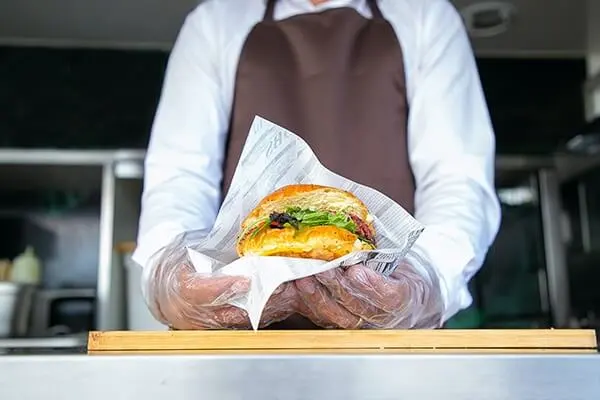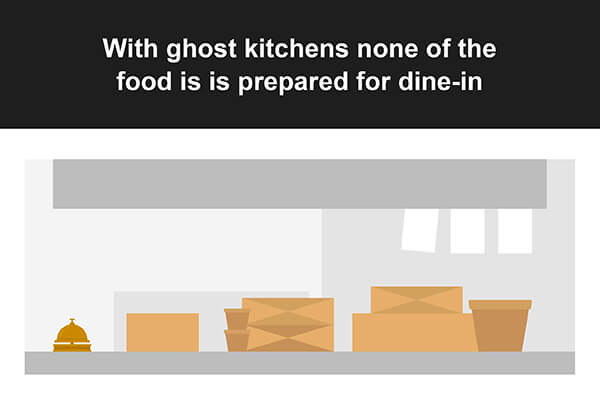April 12, 2021

It’s no secret that ghost kitchens are a hot topic in the food industry. Even before the pandemic, these virtual restaurants were shedding the standard brick-and-mortar model and seeing great returns.
Since COVID-19 has changed the dynamics of dining, ghost kitchens are taking off! In fact, they are expected to account for $1 trillion in sales worldwide by 2030. If you are looking for innovative ways to expand your client base and increase profits, read on for more details from our restaurant suppliers.
Our Commercial Kitchen Suppliers Answer FAQs About Ghost Kitchens
Ghost kitchens are a unique realm within the restaurant industry. While all food for ghost kitchens is prepared in a commercial or professional kitchen, none of the food is consumed for dine-in. Instead, these kitchens rely primarily on online ordering and delivery to get their food to their clientele. This means there are no servers, seating, or need for reservation management.

In effect, ghost kitchens are completely virtual brands built around the concept of “off-premise dining,” utilizing mobile technology to get the job done. All orders received by ghost kitchens are made through an in-house or third-party online app, and items are delivered directly to customers’ doors.
How Do Ghost Restaurants Work?
The genius behind the ghost restaurant concept is that a new or existing establishment can create a full menu and brand without investing in dining space, tableware, decor, or waitstaff. Restaurant owners can focus primarily on food production and execution, with little overhead, since all food is prepared for takeaway.
The basic framework for starting a ghost kitchen is in some ways similar to launching any new restaurant, with a few striking differences:
- All ghost kitchens and brick-and-mortars start with developing a menu and brand identity. Ghost kitchens, however, allow restaurateurs to construct multiple menus. For example, celebrity Chef Eric Greenspan’s model runs four distinct cuisines from his central ghost kitchen.
- Restaurateurs building a virtual brand typically rent culinary space from a commissary landlord or through a nationally run facility like Kitchens United or Cloud Kitchens. These are strictly production spaces, so restaurateurs do not have to furnish a dining area, outfit a bar, etc.
- For marketing and sales opportunities, most ghost kitchen owners partner with delivery services to get their name out there. Some, however, develop their own in-house delivery service and online marketing campaigns to maximize profits.

Perhaps one of the most compelling aspects of ghost kitchens is their flexibility. With an existing brand and their own restaurant, restaurant owners can still design a secondary concept and offer it as off-premise dining while utilizing their kitchen. Also referred to as a virtual kitchen, separate brands get to co-exist under one roof, but only one is associated with the restaurant itself; the other is entirely virtual. If you are new to ghost and virtual kitchens, it’s a good idea to reach out to your culinary community for guidance. Your local bulk food supplier often has valuable resources to get you started on your journey.
Get Going with Mobile Technology
If you are new to virtual brands and ghost kitchens it’s important to recognize that technology’s role in creating a productive establishment is essential. To build a successful ghost kitchen, owners need the right technology to streamline orders and maximize profits.
- Online ordering platforms are a must to manage orders and build a virtual brand.
- Mobile apps that help track inventory and allow automated ordering are great tools for your virtual kitchen.
- Social media marketing technologies, like Buffer, Facebook marketing campaigns, and SEO strategies, can help boost your online presence and analyze marketing metrics.
Is a Ghost Kitchen Right For Your Business?
The popularity of ghost kitchens is understandable. They allow restaurant owners to go from menu development to sales quickly, with low starting costs. Ghost kitchens, similar to food trucks and pop-ups, enable new business owners to experiment with recipes and concept development, and build a brand before making a larger commitment to a brick-and-mortar. Plus, virtual kitchens align with customers’ current appreciation for contactless dining and safe ordering.
Wholesale Food and More from Our Restaurant Supply Company
At US Foods CHEF'STORE, you’ll discover everything you need to make dynamic menus and get your virtual kitchen off the ground. In addition to exceptional wholesale meat, seafood, and produce, we carry eco-friendly to-go supplies at competitive prices. To learn more about how we can help you, stop by one of our convenient locations or take a look at our restaurant business tools.